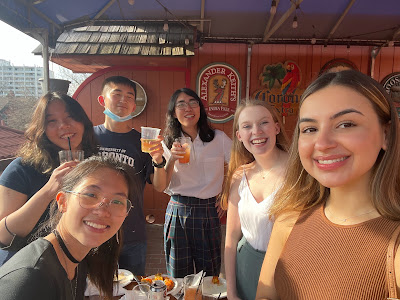The 6th Workshop on Innovations in Cantonese Linguistics (WICL) is a biennial conference that focuses on new advances in Cantonese linguistics, such as innovation in methodologies, tools, and or computing software. This year it will be held virtually by Ohio State University on May 27th - May 28th 2022.
Justin Leung (Graduate Student), Brian Diep (Undergraduate Student) and Naomi Nagy (Faculty) will be presenting their work on " 'Lazy pronunciation' in Toronto Heritage Cantonese: The case of (n-/l-)"! They will be presenting on May 27th. Their abstract can be found below!
The event is free of change but registration is required. We encourage all to attend!
'Lazy pronunciation' in Toronto Heritage Cantonese: The case of (n-/l-)
In Hong Kong Cantonese, there is a group of sound changes in progress colloquially known as 懶音 ‘lazy
pronunciation’. A well-known example is the alternation between syllable-initial /n/ and /l/, which is often
characterized as a merger of /n/ to /l/ (Zee 1999; To et al. 2015; i.a.), e.g., pronouncing 南 /naːm²¹/ ‘south’
like 藍 /laːm²¹/ ‘blue’. While this merger is sometimes reported to be complete or near-completion (Zee
1999; To et al. 2015), some variation is observed, with age and gender suggested as important factors conditioning variant choice (Ng 2017; Liang 2018), as well as an expectation that heritage speakers may differ
from homeland speakers. For example, Cantonese-English bilinguals in Vancouver are found to differentiate /n/ and /l/ in English but merge the two phonemes in Cantonese (Soo et al. 2021). However, little work
has teased apart the linguistic and social factors that contribute to this variation.
We investigated the factors that contribute to variation and compare the realization of /n-/ and /l-/
in heritage speakers in Toronto and homeland speakers in Hong Kong. If there is influence from English,
which differentiates /n/ and /l/, we expect heritage speakers to have less [l] for /n-/ and [n] for /l-/. However,
if heritage speakers amplify the change (due to less pressure to conform to a standard, less exposure to
homeland speech, or categorical perception as /l/), we would expect them to have greater (perhaps categorical) usage of [l].
We analyzed spontaneous spoken data from sociolinguistic interviews (14 speakers) in Cantonese
from the Heritage Language Documentation corpus (Nagy 2011). The corpus includes homeland speakers
in Hong Kong and three generations of heritage speakers in Toronto. Tokens of syllables with /n-/ or /l-/ as
the onset were extracted and coded impressionistically (and cross-checked) for the variable (n-/l-) and linguistic factors (vowel backness, vowel height, vowel length, tone, previous segment). We also considered
the social factors of generation, ethnic orientation and gender of the speakers. The tokens were classified
as underlyingly /n-/ or /l-/ based on 19th-century sources (from 粵音資料集叢 https://jyut.net), and these
were accordingly analyzed in separate mixed-effects logistic regression models.
504 tokens were extracted (418 /n-/, 86 /l-/) after excluding characters categorically realized as [l].
For the /n-/ tokens, there is more retention of [n] after a previous (coda) nasal, conditioning by the tone and
following vowel, as well as significant differences by generation, gender and ethnic orientation. Although
generation is significant, there is no monotonic relationship suggesting an advance of the change across
heritage generations. In contrast, for the /l-/ tokens, a nasal coda in the preceding syllable significantly
favoured realization as [n], and there was no other conditioning. That is, in both datasets, there is a preference to produce [n] after a nasal. The results also confirm one finding in the literature, that /l-/ is less likely
to surface as [n] than the other way around, but do not provide any evidence of a different pattern between
heritage and homeland speakers.
References
Liang, Y. 2018. 再探討香港粵語聲母 /n-/、/l-/ 不分. Current Research in Chinese Linguistics 97(1):
101–110.
Nagy, N. 2011. A multilingual corpus to explore geographic variation. Rassegna Italiana di Linguistica
Applicata 43(1–2): 65–84.
Ng, C. L. C. 2017. Merger of the syllable-initial [n-] and [l-] in Hong Kong Cantonese. Outstanding Academic Papers by Students. http://dspace.cityu.edu.hk/handle/2031/100.
Soo, R., Johnson, K. A., & Babel, M. 2021. Sound change in spontaneous bilingual speech. Proceedings of
Interspeech 2021, 421–425.
To, C. K. S., McLeod, S., & Cheung, P. S. P. 2015. Phonetic variations and sound changes in Hong Kong
Cantonese. Clinical Linguistics & Phonetics 29(5): 333–353.
Zee, E. 1999. Change and variation in the syllable-initial and syllable-final consonants in Hong Kong Cantonese. Journal of Chinese Linguistics 27(1): 120–167.
















